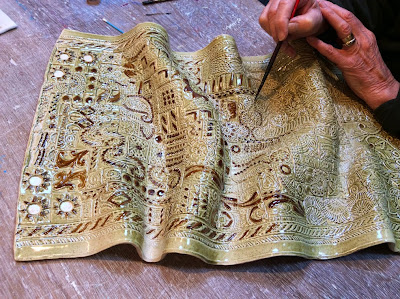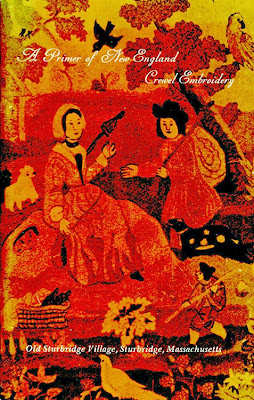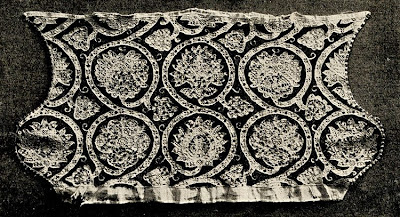Last weekend I was in the Peak District. The weather was lovely and promised good walking. I also wanted to drop by an important ceramics fest to see what was new. What struck me this year was the amount of ceramics that owed their inspiration to textiles. Margaret Gardiner is well-known for her intricately designed, opalescent pots and I spent time with her talking about the lengthy process involved. As you might detect from the example of her work above, Margaret impresses near leather-hard clay with her favourite pieces of lace and crochet to create this unique surface, which also seems speckled with sequins.
In the special exhibition gallery, Pollie and Gary Uttley had a special exhibition of ceramic wall decorations - hangings - inspired by textiles during their visits to India.
Seen from a distance they appeared just like gently folded cloths, down to their embedded shisha mirrors.
So did I bring back any of this textile inspiration? Not this time. I was rather taken with the work of a Yorkshire ceramist from York, called Chiu-I Wu and I carried home two of her meditative pieces for my studio, as a counter balance, I suppose, to some of the embroidered items there.....
Sunday 29 June 2014
Saturday 28 June 2014
SOLD Catalogue of Embroideries + Full Colour Exhibition Guide Lady Lever Art Gallery * £20 €38 $90 Including Shipping (New Zealand & Australia $100)
Some years ago the Lady Lever Art Gallery had a display of early needlework and I was lucky to be there and to have bought an exhibition guide in addition to the catalogue of the complete embroideries.
This is a lovely softback guide of 16 pages in mint condition.
The catalogue itself is a rather heftier affair (to explain the more expensive overseas shipping) with over 300 pages. This copy is paperback and is in excellent condition.
The catalogue covers all forms of needlework and is richly illustrated in colour and in black and white. So you will enjoy needleworked gloves
stump work panels
and decorative Stuart silk-work pictures
not forgetting samplers!
The piece above I just had to show you - it is one of my favourite panels.
And then there are fabulous Stuart panels. Some time ago I saw the film Argo and spotted this antique Persian mirror in the background to one scene - the shape is a dead ringer for the Stuart mirror above.....I wonder.....??
This is a lovely softback guide of 16 pages in mint condition.
The catalogue itself is a rather heftier affair (to explain the more expensive overseas shipping) with over 300 pages. This copy is paperback and is in excellent condition.
The catalogue covers all forms of needlework and is richly illustrated in colour and in black and white. So you will enjoy needleworked gloves
stump work panels
and decorative Stuart silk-work pictures
not forgetting samplers!
The piece above I just had to show you - it is one of my favourite panels.
And then there are fabulous Stuart panels. Some time ago I saw the film Argo and spotted this antique Persian mirror in the background to one scene - the shape is a dead ringer for the Stuart mirror above.....I wonder.....??
SOLD 3 Books * English Embroideries + Point of the Needle + Primer of New England Embroidery * £15 €25 $60 Shipping Included
There are 3 wonderful books for you here. Even if you are not planning to visit the Micheal and Elizabeth Feller Collection at the Ashmolean this summer curated by Mary M Brooks, you will enjoy her guide book to the Early English embroideries in the Ashmolean.
This is a classic book authored by one of the pre-eminent British textile historians covering items from a superb collection. The 96 page, well-illustrated book is in pristine condition.
And there is the fabulous book by the wonderful Dorothy Bromiley Phelan, another of Needleprint's celebrated authors.
Dorothy has a real love of samplers and it shows beautifully in her excellent descriptions of these fabulous needle-worked items.
This is also a 96 page full colour book in excellent condition.
And, just to round off a trio of lovely books is this book from Old Stourbridge Village, Massachusetts.
This 76 page softback is dedicated to teachin you the elements of 17th and 18th century crewel needlework as practised by the ladies of New England
This book also is softback and the condition is a little less than perfect but still very good.
This is a classic book authored by one of the pre-eminent British textile historians covering items from a superb collection. The 96 page, well-illustrated book is in pristine condition.
And there is the fabulous book by the wonderful Dorothy Bromiley Phelan, another of Needleprint's celebrated authors.
Dorothy has a real love of samplers and it shows beautifully in her excellent descriptions of these fabulous needle-worked items.
This is also a 96 page full colour book in excellent condition.
And, just to round off a trio of lovely books is this book from Old Stourbridge Village, Massachusetts.
This 76 page softback is dedicated to teachin you the elements of 17th and 18th century crewel needlework as practised by the ladies of New England
This book also is softback and the condition is a little less than perfect but still very good.
SOLD A Book of Old Embroidery 1921 * £20 €30 $70 Shipping Included (New Zealand Australia $80)
Nearly 100 years old, this book has seen life and life has not been that kind to it. It is one of my rescue purchases
from a bookshop in the Lake District where heating and weather are not the best. And this book has seen a lot of use - so much so that the front cover has divorced the book - though they are still living together. So, I would describe this wonder simply as being in acceptable condition.
However the 87 plates are terrific - there are some colour pages, which is quite a surprise, given the age of the book, but the majority are in black and white.
As this is a very rare find, I am trying to give you as many images as possible, since not everyone will be able to have a copy, but maybe these images will be of use to researchers.
There is only one sampler illustrated - and here it is.
Jackets and coifs come a-plenty
and here is a close up of that rarely seen, fabulous coif above.
I had never before seen the bodice shown here
and here again is some close up detail for you to enjoy.
It's important to say that this is not a book of English embroidery - there are examples of early embroidery from other European countries as well as a few items from Persia, which again fuel my interest as sometimes they recall Stuart dress.
Above you can see one of the colour plates - it is integral to the book an is not mounted separately.
Embroidered gloves are always fabulous to see.
and these Italian embroidered panels are just bellissimi.
The Panel below is not a Stuart panel, but is a contemporary of those pieces. It is Dutch and resembles closely some aspects of the English panels.
I am captivated by the detail of the women's skirts which show wonderful embroidered panels - the décolletées look rather more adventurous, though, than I think would have been deemed respectable by Dutch ladies of the time.... can anyone from the Netherlands help here?
So this is a large soft-back book in two parts - front page separated - in acceptable condition, but a treasure-house of old embroidery.
However the 87 plates are terrific - there are some colour pages, which is quite a surprise, given the age of the book, but the majority are in black and white.
As this is a very rare find, I am trying to give you as many images as possible, since not everyone will be able to have a copy, but maybe these images will be of use to researchers.
There is only one sampler illustrated - and here it is.
Jackets and coifs come a-plenty
and here is a close up of that rarely seen, fabulous coif above.
I had never before seen the bodice shown here
and here again is some close up detail for you to enjoy.
It's important to say that this is not a book of English embroidery - there are examples of early embroidery from other European countries as well as a few items from Persia, which again fuel my interest as sometimes they recall Stuart dress.
Above you can see one of the colour plates - it is integral to the book an is not mounted separately.
Embroidered gloves are always fabulous to see.
and these Italian embroidered panels are just bellissimi.
The Panel below is not a Stuart panel, but is a contemporary of those pieces. It is Dutch and resembles closely some aspects of the English panels.
I am captivated by the detail of the women's skirts which show wonderful embroidered panels - the décolletées look rather more adventurous, though, than I think would have been deemed respectable by Dutch ladies of the time.... can anyone from the Netherlands help here?
So this is a large soft-back book in two parts - front page separated - in acceptable condition, but a treasure-house of old embroidery.
Friday 27 June 2014
SOLD Samplers of the Pennsylvania Germans * £80 €120 $200 Including Shipping (New Zealand & Australia $215)
300 pages of Pennsylvanian Samplers in colour, black & white, details, charted excerpts, history, origins, incredible research... and more and more than that. Excellent condition book with very good jacket in protective cover. Can be purchased with costs split over 2 months to help smooth the budget.
It was my privilege when I was in Deerfield in 2005 attending a symposium on the European origins of American samplers to talk with Tandy Hersh and discuss links between Moravian and Quaker samplers.
There is something very special about these samplers and it has to do with repetition and clear spacing which lends a distinctive rhythm to the overall surface. Colour choice is usually a limited palette, which provides a sense of unity for all the small motifs.
There are a number of charted patterns throughout the book - this one here reminds me of similar motifs on Vierlander samplers.
Like the Quaker medallions, these samplers appear to have a unique vocabulary of motifs which is transmitted across communities and time.
As you can see from these representative pages, all the images are a good size and fill the page.
Above is one of my own special favourites because of the free-form flowers at the base of the sampler.
This rose and black palette reminds me of the samplers from Alsace - and indeed many migrating families from Germany to the US would stop off en-route in Switzerland or the Palatinates which included the area that is now Alsace.
The heart in this detail shot is reminiscent of hearts found on Swedish bridegrooms' shirts
What you can see above is a sampler design drawn out on a hand-drawn grid - this is just so fascinating to see the pre-plans made for the stitching, it helps so much in our understanding of how samplers were designed and arranged. The exact hand-drawing of the grid must have been time-consuming and tedious - oh, and if you made a mistake......
And I couldn't help but show you this sampler, too. I love it!
It was my privilege when I was in Deerfield in 2005 attending a symposium on the European origins of American samplers to talk with Tandy Hersh and discuss links between Moravian and Quaker samplers.
There is something very special about these samplers and it has to do with repetition and clear spacing which lends a distinctive rhythm to the overall surface. Colour choice is usually a limited palette, which provides a sense of unity for all the small motifs.
There are a number of charted patterns throughout the book - this one here reminds me of similar motifs on Vierlander samplers.
Like the Quaker medallions, these samplers appear to have a unique vocabulary of motifs which is transmitted across communities and time.
As you can see from these representative pages, all the images are a good size and fill the page.
Above is one of my own special favourites because of the free-form flowers at the base of the sampler.
This rose and black palette reminds me of the samplers from Alsace - and indeed many migrating families from Germany to the US would stop off en-route in Switzerland or the Palatinates which included the area that is now Alsace.
The heart in this detail shot is reminiscent of hearts found on Swedish bridegrooms' shirts
What you can see above is a sampler design drawn out on a hand-drawn grid - this is just so fascinating to see the pre-plans made for the stitching, it helps so much in our understanding of how samplers were designed and arranged. The exact hand-drawing of the grid must have been time-consuming and tedious - oh, and if you made a mistake......
And I couldn't help but show you this sampler, too. I love it!
Subscribe to:
Posts (Atom)





















































